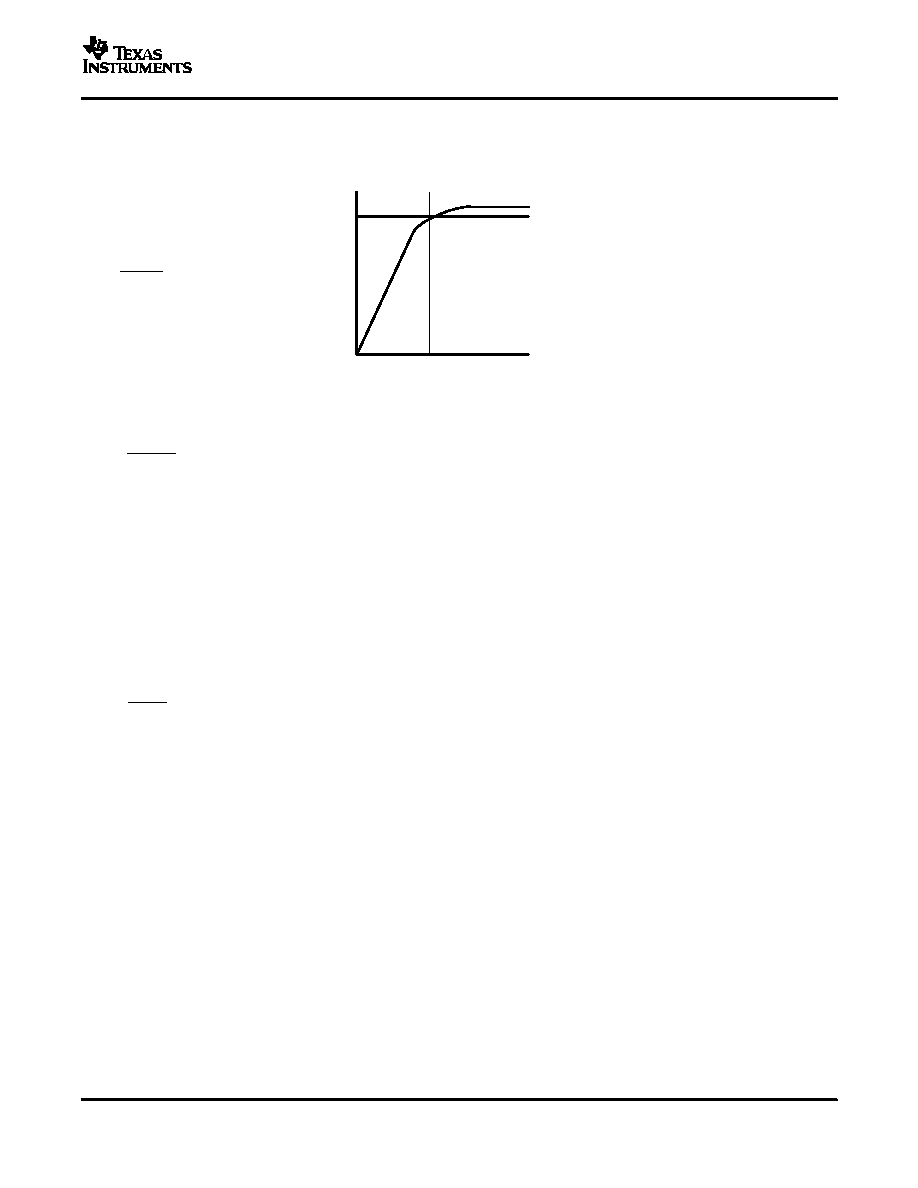- 您現(xiàn)在的位置:買賣IC網(wǎng) > PDF目錄98269 > TPA2000D1PWR (TEXAS INSTRUMENTS INC) 2 W, 1 CHANNEL, AUDIO AMPLIFIER, PDSO16 PDF資料下載
參數(shù)資料
| 型號: | TPA2000D1PWR |
| 廠商: | TEXAS INSTRUMENTS INC |
| 元件分類: | 音頻/視頻放大 |
| 英文描述: | 2 W, 1 CHANNEL, AUDIO AMPLIFIER, PDSO16 |
| 封裝: | GREEN, PLASTIC, TSSOP-16 |
| 文件頁數(shù): | 5/23頁 |
| 文件大?。?/td> | 500K |
| 代理商: | TPA2000D1PWR |

www.ti.com
INPUT CAPACITOR, Ci
fc +
1
2 p Z
i
C
i
3 dB
fc
(5)
C
i +
1
2p Z
i fc
(6)
C
i v
C
BYP
10
(7)
POWER SUPPLY DECOUPLING, CS
MIDRAIL BYPASS CAPACITOR, CBYP
TPA2000D1
SLOS328F – JUNE 2000 – REVISED MARCH 2004
In the typical application an input capacitor (Ci) is required to allow the amplifier to bias the input signal to the
proper dc level for optimum operation. In this case, Ci and the input impedance of the amplifier (Zi) form a
high-pass filter with the corner frequency determined in Equation 5.
The value of Ci is important because it directly affects the bass (low frequency) performance of the circuit.
Consider the example where Zi is 20 k and the specification calls for a flat bass response down to 80 Hz.
Equation 5 is reconfigured as Equation 6.
In this example, Ci is 0.1 F, so one would likely choose a value in the range of 0.1 F to 1 F. If the gain is
known and constant, use Zi from Table 1 to calculate Ci. A further consideration for this capacitor is the leakage
path from the input source through the input network (Ci) and the feedback network to the load. This leakage
current creates a dc offset voltage at the input to the amplifier that reduces useful headroom, especially in high
gain applications. For this reason, a low-leakage tantalum or ceramic capacitor is the best choice. When
polarized capacitors are used, the positive side of the capacitor should face the amplifier input in most
applications as the dc level there is held at VDD/2, which is likely higher than the source dc level. It is important to
confirm the capacitor polarity in the application.
Ci must be 10 times smaller than the bypass capacitor to reduce clicking and popping noise from power on/off
and entering and leaving shutdown. After sizing Ci for a given cutoff frequency, size the bypass capacitor to 10
times that of the input capacitor.
The TPA2000D1 is a high-performance CMOS audio amplifier that requires adequate power supply decoupling
to ensure the output total harmonic distortion (THD) is as low as possible. Power supply decoupling also
prevents oscillations for long lead lengths between the amplifier and the speaker. The optimum decoupling is
achieved by using two capacitors of different types that target different types of noise on the power supply leads.
For higher frequency transients, spikes, or digital hash on the line, a good low equivalent-series-resistance (ESR)
ceramic capacitor, typically 0.1 F placed as close as possible to the device VDD lead works best. For filtering
lower-frequency noise signals, a larger aluminum electrolytic capacitor of 10 F or greater placed near the audio
power amplifier is recommended.
The midrail bypass capacitor (CBYP) is the most critical capacitor and serves several important functions. During
start-up or recovery from shutdown mode, CBYP determines the rate at which the amplifier starts up. The second
function is to reduce noise produced by the power supply caused by coupling into the output drive signal. This
noise is from the midrail generation circuit internal to the amplifier, which appears as degraded PSRR and
THD+N.
Bypass capacitor (CBYP) values of 0.47-F to 1-F ceramic or tantalum low-ESR capacitors are recommended for
the best THD and noise performance.
13
相關(guān)PDF資料 |
PDF描述 |
|---|---|
| TPA2000D1PW | 2 W, 1 CHANNEL, AUDIO AMPLIFIER, PDSO16 |
| TPA2000D1GQCR | 2 W, 1 CHANNEL, AUDIO AMPLIFIER, PBGA48 |
| TPA2000D1PWRG4 | 2 W, 1 CHANNEL, AUDIO AMPLIFIER, PDSO16 |
| TPA2000D1PWG4 | 2 W, 1 CHANNEL, AUDIO AMPLIFIER, PDSO16 |
| TPA2000D1TPWRG4Q1 | 2 W, 1 CHANNEL, AUDIO AMPLIFIER, PDSO16 |
相關(guān)代理商/技術(shù)參數(shù) |
參數(shù)描述 |
|---|---|
| TPA2000D1PWRG4 | 功能描述:音頻放大器 Mono Filter-Free Class-D RoHS:否 制造商:STMicroelectronics 產(chǎn)品:General Purpose Audio Amplifiers 輸出類型:Digital 輸出功率: THD + 噪聲: 工作電源電壓:3.3 V 電源電流: 最大功率耗散: 最大工作溫度: 安裝風(fēng)格:SMD/SMT 封裝 / 箱體:TQFP-64 封裝:Reel |
| TPA2000D1-Q1 | 制造商:TI 制造商全稱:Texas Instruments 功能描述:2-W FILTERLESS MONO CLASS-D AUDIO POWER AMPLIFIER |
| TPA2000D1TPWRG4Q1 | 功能描述:音頻放大器 Mono Filter-Free Class-D Audio Amp RoHS:否 制造商:STMicroelectronics 產(chǎn)品:General Purpose Audio Amplifiers 輸出類型:Digital 輸出功率: THD + 噪聲: 工作電源電壓:3.3 V 電源電流: 最大功率耗散: 最大工作溫度: 安裝風(fēng)格:SMD/SMT 封裝 / 箱體:TQFP-64 封裝:Reel |
| TPA2000D1TPWRQ1 | 功能描述:音頻放大器 Auto Cat Mono Filter Free Class D RoHS:否 制造商:STMicroelectronics 產(chǎn)品:General Purpose Audio Amplifiers 輸出類型:Digital 輸出功率: THD + 噪聲: 工作電源電壓:3.3 V 電源電流: 最大功率耗散: 最大工作溫度: 安裝風(fēng)格:SMD/SMT 封裝 / 箱體:TQFP-64 封裝:Reel |
| TPA2000D2 | 制造商:TI 制造商全稱:Texas Instruments 功能描述:2-W FILTERLESS STEREO CLASS-D AUDIO POWER AMPLIFIER |
發(fā)布緊急采購,3分鐘左右您將得到回復(fù)。